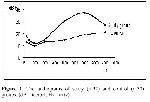Workers in a local hydroelectric powerhouse (Keban, Elazig, Turkey) were recruited to form the study group. Control group was consisted of 30 voluntary males with similar age who are working in the same powerhouse with normal hearing who were. Study and control groups were composed of 40 patients (mean age 37±5 year) and 37 subjects (mean age 36±4 year), respectively. All of the subjects in study and control groups were male. Eight patients from study and seven patients from control group who have history of cigarette smoking is excluded from this sudy and it was created with 32 study patients (mean age 37±3 year)and 30 study subject. (mean age 36±6 year)
A questionnaire form was applied to all subjects in the study. In the questionnaire; date of the birth, age of initializing to work, duration of working, daily working and resting times were compiled. The patients who have history of using ototoxic drugs, previous ear diseases, trauma to head and the ear and familial history of hearing diseases were excluded from the study.
Noise levels were measured by a noise measurer (Bruel and Kjaer 2235, Cophenagen, Denmark). The mean level of noise was determined to be altering between 95-116 dB in the hydroelectyearic powerhouse. The period being exposed to noise is 8 hours per day. The mean duration of working in the power house of workers with NIHL was 18±5 year.
The audiometric tests were performed in a sound-proof chamber with an Interacoustics AC-40 audiometer (Denmark) that was calibrated according to ISO 1964 standards as we reported previously 11. Pure tone audiometry was applied to all patients and controls. For the escape from temporary threshold alteration induced by noise, hearing measures were taken after 24 hours with noiseless resting period. Frequencies at octave intervals from 250 to 8000 Hz were tested for air conduction and from 500 to 4000 Hz for bone conduction. Hearing level was accepted as abnormal if the hearing threshold was 25 dB or more below than the age-corrected level at two or more test frequencies. In our criterion for NIHL, hearing threshold is normally at 1 kHz but hearing loss is more than 25 dB at 4-6 kHz.
Fasting blood samples were obtained from all subjects for biochemial analysis. Levels of HDL-C and LDL-C were measured by an autoanalyzer (Olympus AU 600) using commercially available kits (Olympus Optical Co. Ltd., Japan). For determination of PON1, modified methods of Ecerson 12, Juretic 13 and Mackness 14 were used as we recenly reported 15. Statistical analyses were performed using SPSS program for windows, version 10.0 (SPSS Inc., Chicago, IL, USA). All test used were two-tailed and P less than 0.05 was considered as significant. The data are given as mean ± standard deviation (SD). Comparison between groups were performed using the Students t test. Pearson correlation coefficient was used to assess the relationship between variables.




